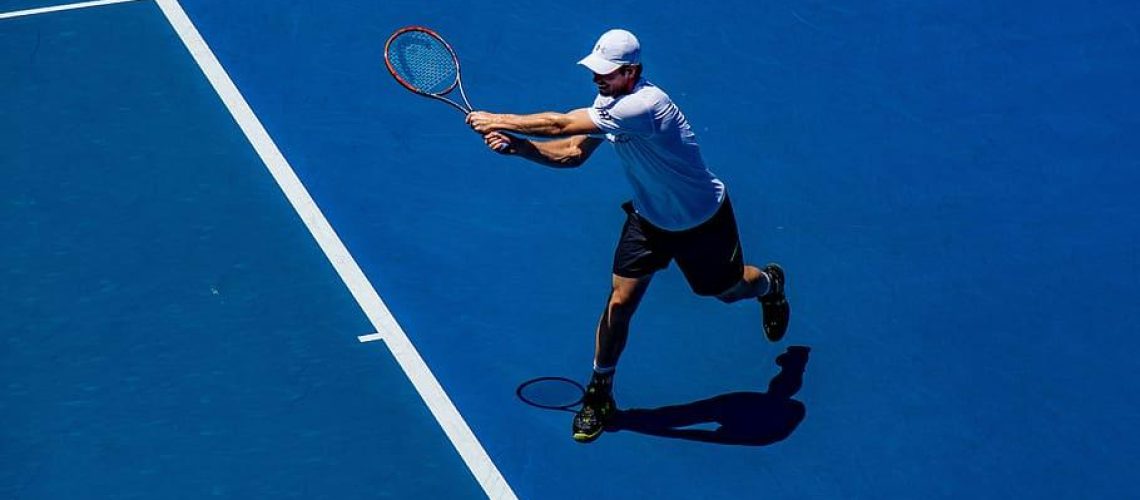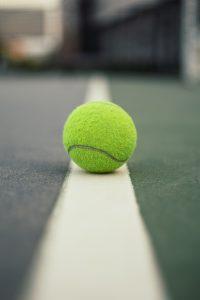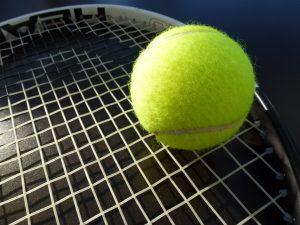We may earn money or products from the companies mentioned in this post.
Introduction

When it comes to tennis, the performance of your racket can make or break your game One often overlooked aspect of maintaining optimal performance is restringing your tennis racket regularly Not only does restringing help preserve the integrity of your racket, but it also plays a key role in injury prevention
The Importance of Restringing
Maintaining Optimal Performance:
Restringing your tennis racket ensures that the strings are at their ideal tension, allowing for better control and power during each shot Over time, constant use can cause the strings to lose tension and become less responsive By restringing, you bring back the original liveliness and feel of your racket, giving you an edge on the court
Preventing Injury:
When the strings on a tennis racket become worn out or damaged, they can create uneven tension across the surface This imbalance increases the risk of injuries such as wrist strain or tendonitis Regularly restringing your racket helps maintain consistent string tension, reducing these risks and keeping you safe during intense matches
Factors Affecting the Need for Restringing
-
Frequency of Play:
The more frequently you play tennis, the faster your strings will wear out Intense hitting sessions and regular competitive play contribute to greater stress on the strings, necessitating more frequent restringing -
Playing Style:
Your playing style also affects how quickly your strings wear out Aggressive players who generate heavy topspin or hit with lots of power put more strain on their strings compared to those who rely on finesse and control -
String Material and Tension:
Different string materials have varying durability Natural gut strings tend to offer excellent playability but may require more frequent restringing Additionally, the tension at which you string your racket affects its performance and longevity Higher tensions can lead to faster loss of tension over time
By considering these factors and regularly restringing your tennis racket, you can ensure that it performs optimally and reduces the risk of injury So don’t forget to give your racket some love and attention by scheduling regular restringing sessions!
Tools and Materials Needed for Restringing

Restringing a tennis racket requires specific tools and materials to ensure a successful job Let’s take a look at the essential items you’ll need:
Essential Tools
- Racket Stringing Machine: The heart of the restringing process is the stringing machine itself You have two main options – manual or electronic machines Manual machines are operated by hand, while electronic machines use motors for easier string tension adjustment
- Drop Weight, Crank, or Constant Pull Systems: Within the realm of manual stringing machines, you can choose between drop weight, crank, or constant pull systems Each has its own advantages and disadvantages, so consider your preferences and needs when making a selection
- Awl Tool: To remove existing strings from your racket, you’ll need an awl tool This handy instrument helps release tension in the strings and makes it easier to replace them
- Needle-Nose Pliers: Cutting strings cleanly is crucial during the restringing process Needle-nose pliers are perfect for this task as they allow precise cutting without damaging the racket or other components
Choosing the Right String
Selecting the right tennis string is essential for optimizing your performance on the court Consider these factors when making your decision:
-
Types of Tennis Strings: There are various types of strings available in the market, each offering different characteristics and benefits
- Natural Gut: Known for its excellent playability and comfort, natural gut strings provide great feel but come at a higher cost compared to synthetic options
- Synthetic Gut: These strings are made from nylon and offer a good balance of playability, durability, and affordability They are a popular choice among recreational players
- Polyester: Polyester strings excel in durability and control, making them suitable for players who generate a lot of power but want more precision in their shots
- Multifilament: Offering a softer feel compared to polyester, multifilament strings provide better shock absorption and comfort They are ideal for players seeking arm-friendly options
- Kevlar: Kevlar strings are extremely durable and can withstand heavy hitters, but they lack the comfort and feel offered by other types of strings They are commonly used as hybrid combinations with other materials
- Tension Selection According to Player’s Needs: The tension at which you string your racket can significantly impact your game Higher string tension offers more control but sacrifices power, while lower tension provides greater power but reduces control Consider your playing style and preferences when determining the appropriate tension level
By having the right tools and choosing the perfect string for your needs, you’ll be ready to restring your tennis racket like a pro!
Step-by-Step Guide to Restringing a Tennis Racket

Preparation before restringing
Before diving into the restringing process, it’s important to prepare your tennis racket properly The first step is removing the old strings This can be done by cutting them with string cutters and carefully unwinding them from the racket frame
Once the old strings are removed, it’s time to clean the grommets These small plastic pieces that hold the strings in place can accumulate dirt and debris over time, affecting the string movement Use a soft cloth or a toothbrush to gently remove any dirt or residue from the grommet holes
Setting up the racket on the stringing machine
Now that you have a clean slate, it’s time to set up your racket on a stringing machine for restringing Make sure to mount the racket securely on the machine’s clamps or supports, ensuring stability throughout the process
Setting appropriate tension is crucial for achieving optimal performance and feel in your racket Consult your manufacturer’s recommendations or consider factors such as your playing style and preferences when selecting tension levels for your strings
Stringing process
1 Main strings installation
The main strings are typically strung vertically along the frame of the racket, forming a grid-like pattern To start, tie a starting knot at one end of the racket frame using an appropriate knotting technique
Next, use a weaving technique to thread each main string through alternating grommet holes along one side of the racket until you reach the other end This ensures an even distribution of tension across all main strings
To secure and finish off the main strings, tie them off using a suitable knot or finishing technique at the end of the racket frame This will prevent them from unraveling during play
2 Cross strings installation
The cross strings run horizontally across the main strings, intersecting with them to create a tightly woven pattern Start by selecting either the head or throat of the racket as your starting point for the cross strings
Follow a weaving pattern that alternates over and under each main string, gradually lacing the cross strings through the grommet holes in a consistent manner Take care to maintain proper tension throughout this process
When encountering shared holes where both a main string and a cross string pass through, ensure that they are properly laced together without any twists or tangles
In cases where there are skipped holes between certain grommets, carefully lace the cross strings around these gaps to maintain an even distribution of tension across all strings
As you approach the outermost mainstrings, lace the cross strings around them to secure their position and complete the weaving pattern
To finish off the restringing process, tie off and secure the ends of the cross strings using an appropriate knot or finishing technique This will provide additional stability and prevent any unwanted movement
By following this step-by-step guide, you’ll be able to restring your tennis racket with ease and precision Remember to take your time and pay attention to detail throughout each stage of this process for optimal results on court
Tips and Tricks for Better Restring Results

When it comes to restringing your tennis racket, there are several tips and tricks that can help you achieve better results From proper weaving techniques to adjusting string tension based on your playing preferences, these insights will elevate your restringing game Let’s dive into the details:
Proper Weaving Techniques
Weaving the strings correctly is crucial for maintaining optimal performance Make sure to follow a consistent pattern, whether it’s a simple two-piece or more complex hybrid setup Take your time and pay attention to detail during this process
Maintaining Even Tension Throughout the Process
Consistency in tension is key for uniform stringbed response Use a stringing machine with a tensioner that provides accurate readings Pay close attention to each string as you tighten them, ensuring they all reach the desired tension level
Knot Tying Methods to Ensure Secure Strings
To prevent strings from slipping or unraveling prematurely, secure knots are essential Different knot tying techniques exist, such as the double half-hitch or the Parnell knot method Experiment with various methods and find one that works best for you
Adjusting String Tension for Different Playing Preferences
String tension plays a significant role in how your racket performs on the court Consider these factors when determining the right tension:
-
Player’s Level and Style:
Advanced players often prefer higher tensions for added control, while beginner players might opt for lower tensions to enhance power -
Power vs Control:
If you prioritize power, slightly lower string tensions can generate more trampoline effect For enhanced control, higher tensions offer better accuracy -
Comfort and Injury Prevention:
Players experiencing arm discomfort or looking to reduce the risk of tennis-related injuries might benefit from lower string tensions that provide more forgiveness and dampening
By following these tips and tricks, you’ll have all the information you need to confidently restring your tennis racket Remember, finding the right string choice and tension is a process of trial and error Experimentation will help you discover what works best for your individual playing style and preferences So go ahead, restring with confidence!
Useful Links

Ultimate Guide to Tennis Racquet Stringing
How to Choose a Tennis String
A guide to tennis racquet string tension
How to String a Tennis Racket | Step by Step (with Pictures)
Stringing for better control
Mastering Tennis Racquet Stringing
Tennis Racquet Restringing: Types of Strings
How Often Should I Restring My Racket?
How Much Does It Cost To Restring a Tennis Racket?
Racket String / Tennis Racquet Accessories
Replacing vs. Restringing a Tennis Racket
Tennis Racquet Stringing + Home Pickup
How to String a Tennis Racket Without a Machine: DIY Guide
Racket Stringing Service | London
Racquet Stringing Service
Custom Stringing Service – Tennis-Point
Racquet Stringing
How often should you Change Tennis Strings?






